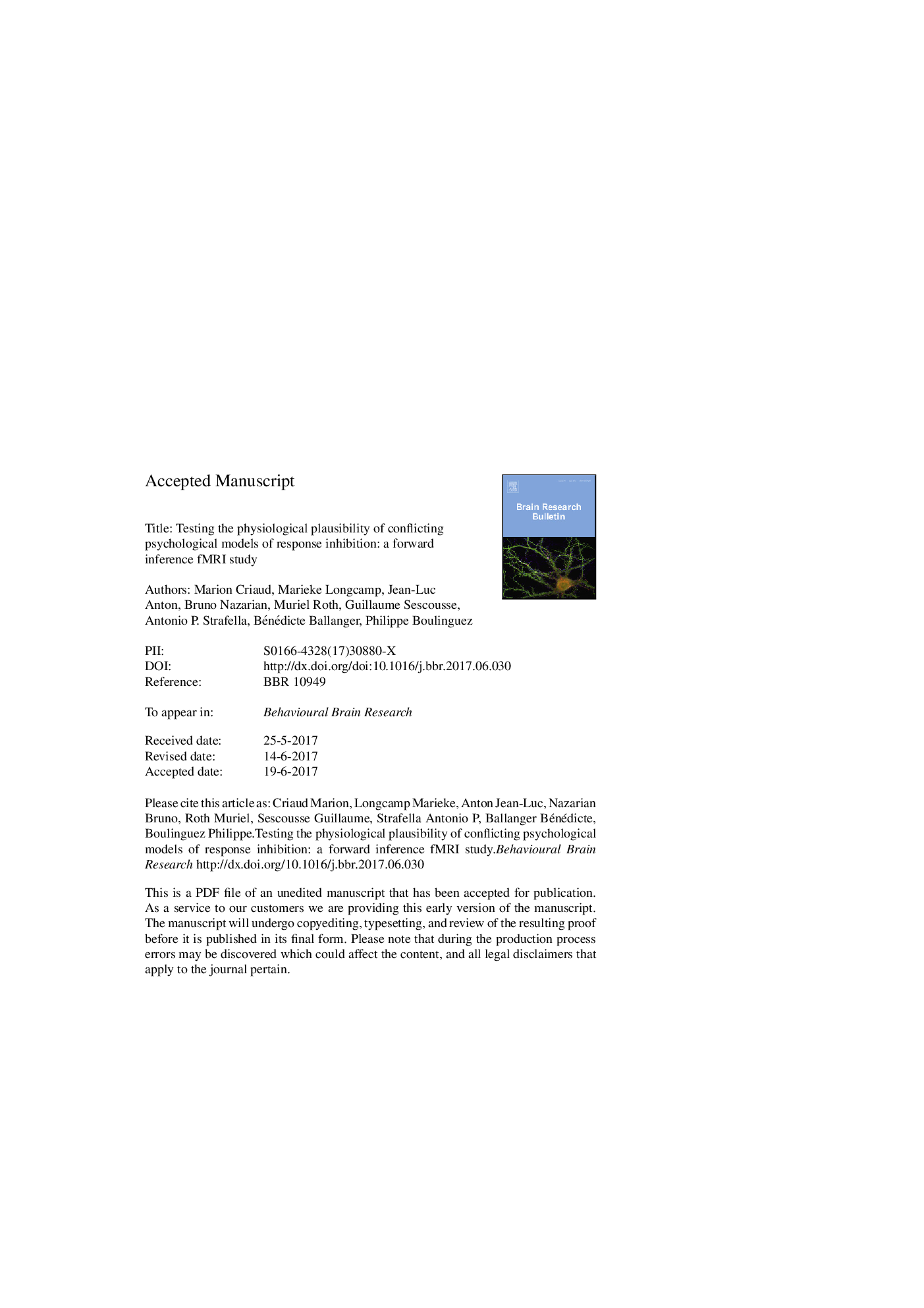| کد مقاله | کد نشریه | سال انتشار | مقاله انگلیسی | نسخه تمام متن |
|---|---|---|---|---|
| 5735376 | 1612902 | 2017 | 34 صفحه PDF | دانلود رایگان |
عنوان انگلیسی مقاله ISI
Testing the physiological plausibility of conflicting psychological models of response inhibition: A forward inference fMRI study
دانلود مقاله + سفارش ترجمه
دانلود مقاله ISI انگلیسی
رایگان برای ایرانیان
کلمات کلیدی
MTGTPJHRFIPLGNGIFGDLPFCTMSMNIDMFcBOLDStgSPMSSTTemporo-parietal junction - اتصال موقتی-پاریتالGo/No-Go - برو / نه بروGo/NoGo - برو / نگوHemodynamic response function - تابع پاسخ همودینامیکTranscranial magnetic stimulation - تحریک مغناطیسی مغزfunctional magnetic resonance imaging - تصویرسازی تشدید مغناطیسی کارکردیfMRI - تصویرسازی تشدید مغناطیسی کارکردیsuperior temporal gyrus - جورج جادویی عالیSMA - دبیرستانlight-emitting diode - دیود نورافشانLED - رهبریreaction time - زمان واکنشinferior frontal gyrus - قارچ پیشانی پایین ترinferior parietal lobule - لوبوئین ترموس پایینSelective inhibition - مهار انتخابیMontreal Neurological Institute - موسسه عصبی مونترالStatistical Parametric Mapping - نقشه برداری پارامترهای آماریfixation point - نقطه ثابتblood-oxygen-level dependent - وابسته به سطح اکسیژن خونStop signal task - کار سیگنال توقفReactive control - کنترل واکنش پذیرProactive control - کنترل پیشگیرانهmiddle temporal gyrus - گریش زمان متوسط
موضوعات مرتبط
علوم زیستی و بیوفناوری
علم عصب شناسی
علوم اعصاب رفتاری
پیش نمایش صفحه اول مقاله

چکیده انگلیسی
The neural mechanisms underlying response inhibition and related disorders are unclear and controversial for several reasons. First, it is a major challenge to assess the psychological bases of behaviour, and ultimately brain-behaviour relationships, of a function which is precisely intended to suppress overt measurable behaviours. Second, response inhibition is difficult to disentangle from other parallel processes involved in more general aspects of cognitive control. Consequently, different psychological and anatomo-functional models coexist, which often appear in conflict with each other even though they are not necessarily mutually exclusive. The standard model of response inhibition in go/no-go tasks assumes that inhibitory processes are reactively and selectively triggered by the stimulus that participants must refrain from reacting to. Recent alternative models suggest that action restraint could instead rely on reactive but non-selective mechanisms (all automatic responses are automatically inhibited in uncertain contexts) or on proactive and non-selective mechanisms (a gating function by which reaction to any stimulus is prevented in anticipation of stimulation when the situation is unpredictable). Here, we assessed the physiological plausibility of these different models by testing their respective predictions regarding event-related BOLD modulations (forward inference using fMRI). We set up a single fMRI design which allowed for us to record simultaneously the different possible forms of inhibition while limiting confounds between response inhibition and parallel cognitive processes. We found BOLD dynamics consistent with non-selective models. These results provide new theoretical and methodological lines of inquiry for the study of basic functions involved in behavioural control and related disorders.
ناشر
Database: Elsevier - ScienceDirect (ساینس دایرکت)
Journal: Behavioural Brain Research - Volume 333, 30 August 2017, Pages 192-202
Journal: Behavioural Brain Research - Volume 333, 30 August 2017, Pages 192-202
نویسندگان
Marion Criaud, Marieke Longcamp, Jean-Luc Anton, Bruno Nazarian, Muriel Roth, Guillaume Sescousse, Antonio P. Strafella, Bénédicte Ballanger, Philippe Boulinguez,